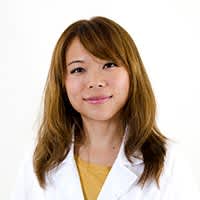
About Julie Jean, MSN, FNP: Julie Jean is a Family Nurse Practitioner who currently practices at Community Medical Wellness Centers USA in Long Beach, California, where she works with primarily disadvantaged patients. Before her current role, Ms. Jean spent ten years as a Registered Nurse, working in a variety of specialties at clinics in Michigan, Texas, and California.
Ms. Jean holds a bachelor’s degree in geology and a BSN from Michigan State University. In 2016, she graduated from Texas Tech University Health Sciences Center’s online MSN program, earning her degree in the FNP specialization.
Interview Questions
[OnlineFNPPrograms.com] May we please have a brief description of your educational and professional background in nursing?
[Julie Jean, MSN, FNP] My first bachelor degree was in geology, and I finished one year of graduate school in geology before leaving the field to pursue other interests. I worked doing transcription for a year, then ultimately decided to return to school for nursing. I completed an accelerated second-degree BSN program at Michigan State University, graduating with honors. I worked for 10 years as an RN in various specialties (PACU, cardiac progressive care, wound care, ER, functional medicine, pediatric private duty) before earning my MSN from Texas Tech University Health Sciences Center in August 2016 with a 4.0 GPA.
I am now working in my first job as a family nurse practitioner. I see all ages of patients at a Federally Qualified Health Center in Southern California. Most of my patients are disadvantaged and have limited access to health care and basic necessities such as housing and transportation. I greatly enjoy working with an underserved population. My position is challenging because I have access to fewer resources than in a private practice, and it is just myself and another new graduate NP running the clinic. However, we have a lot of latitude for critical thinking and creative problem solving.
[OnlineFNPPrograms.com] What motivated you to pursue your MSN online? What advantages did you see to online education? Did the online program at Texas Tech University Health Sciences Center meet these expectations?
[Julie Jean, MSN, FNP] An online MSN program appealed to me due to the flexibility of being able to take classes around my work schedule. I needed to work at least part-time, and liked the option of being able to study in between juggling work and family commitments. I also liked that I did not have to relocate in order to go back to school. The online program at TTUHSC did indeed allow me to have the flexibility to balance the different aspects of my life.
[OnlineFNPPrograms.com] How did TTUHSC’s online platform enable you to interact with faculty members and classmates? Were courses asynchronous, synchronous, or a combination of both? How often did you interact with faculty, and did you feel that your instructors were accessible to online students?
[Julie Jean, MSN, FNP] TTUHSC uses an online classroom that is available 24 hours a day. I could access lectures and assignments whenever I felt inclined. Courses were asynchronous, in that lectures were pre-recorded and posted for students to watch at their convenience. In each course, students were assigned to small groups with particular faculty, and these groups would “meet” via conference call once a semester. Forums were utilized heavily in every course. Students were expected to post to the forums weekly, if not almost daily, and faculty would respond on the forums. Most of the faculty were very timely with their responses and feedback, and overall were highly accessible to the students.
[OnlineFNPPrograms.com] Texas Tech’s online MSN program requires students to make a limited number of visits to the campus for labs and on-campus intensives. What activities and events were included in these on-campus sessions?
[Julie Jean, MSN, FNP] When I was comparing online programs, I considered the number of campus visits that would be required. The University of Texas at Tyler required campus visits at least once a month. TTUHSC required campus visits once a semester in the second half of the program. Texas A&M at Corpus Christi required no campus visits at all. I wanted a program that included at least some campus visits so that I could meet my instructors in person, demonstrate my clinical skills, and get structured feedback. However, I could not spare the time or expense of driving 8 hours every month to spend several days on campus, as UT-Tyler would have required. Therefore, TTUHSC was a happy compromise.
On-campus visits occurred in the last 5 semesters of the program, when students were in the clinical courses. Students had access to TTUHSC’s state-of-the art simulation center, where we could practice conducting focused physical exams on prosthetic body parts. Most of the on-campus visits included Objective Structured Clinical Examinations (OSCEs), in which students demonstrated what we learned on real patients in a simulated exam room setting. After OSCEs, we met in small groups for seminars on topics relevant to nurse practitioner licensing and practice. There was also one on-campus lab that covered procedures such as suturing and casting, and was very beneficial.
[OnlineFNPPrograms.com] What were the major pros and cons of pursuing your graduate nursing degree online? What challenges did you encounter throughout your completion of the online program, and how did you address them? On the flip side, what did you enjoy most about completing your MSN degree online?
[Julie Jean, MSN, FNP] The pros of pursuing an online graduate nursing program were flexibility and, in the case of TTUHSC, affordable cost. I enjoyed being able to study at my own pace in the online program. However, it could be challenging to study when assignment instructions or lecture content needed clarification, and students had to wait a few days to receive responses from faculty. At times, students had to rely on classmates for answers. We learned that we had to help each other out as much as possible, especially since in some units, we were given a ton of material to learn in a brief amount of time. For example, we were expected to learn about 80 topics in obstetrics on our own in one week. As students, we learned to pool our resources and split up the work so that we could collectively cover more material than any individual could.
By far, the biggest challenge to being in an online program was that students were responsible for arranging our own clinical placements. I had to network vigorously in order to obtain relevant clinical hours to be able to satisfy clinical course requirements. The clinical site and preceptor approval process can be lengthy, so we were encouraged to request placements well ahead of time. The clinical placement process was stressful and there were times when my clinical arrangements almost fell through. Students could not complete a course if the minimum clinical hours were not met, and it was my understanding that if we could not finish a course, we would have to wait one year before the course was available again.
[OnlineFNPPrograms.com] Clinical practicums are a major component of graduate nursing education. Can you briefly describe how Texas Tech University Health Sciences Center handles clinical placements for online students? Can you elaborate on your experiences in your clinical practicum rotations and what were some key takeaways from your rotations that you feel helped you successfully make the transition from being a registered nurse to being a health care provider?
[Julie Jean, MSN, FNP] Although TTUHSC provided a list of sites and preceptors that were used by previous students for clinical hours, it was each student’s responsibility to secure individual placements and negotiate the number of hours and which days they would complete with preceptors. The list was not kept updated, and I called at least a dozen clinics that were no longer taking students or that did not return my calls. My advice for students would be to start networking for preceptors well before the start of the clinical semesters. Get to know the providers at your current workplace, as they will often be willing to offer some clinical hours if they already know you. Another networking strategy is to attend meetings of your local APN chapter, but be prepared for these to be saturated with APN students also searching for preceptors.
To help with the transition from being an RN to a practicing APN, try to be hands-on with as many patients as possible in your clinical rotations. Skill with assessments and diagnoses will only come with experience, so get as much experience as you can. When you graduate and start practicing as a provider, you likely will not have an experienced provider you can turn to with every patient, so you have to quickly get accustomed to seeing patients on your own and making that final call on their care.¬ It is scary and slow going, but if you take the time to look everything up in your references, you will grow more comfortable, knowledgeable, and confident than if you were to rely on what another provider tells you to do. Oftentimes, your employer will pay for a subscription to UpToDate, so use it – it is an invaluable reference in the clinical setting.
[OnlineFNPPrograms.com] What advice would you give students just starting TTUHSC’s online MSN program? More broadly, what advice would you give students who are just starting or considering an online MSN program, whether it be at Texas Tech or another institution?
[Julie Jean, MSN, FNP] Be prepared to teach yourself most of the course material. In graduate school, the faculty are there to guide you and facilitate discussion, but they do not provide as many answers as undergraduate faculty do. The students are expected to be more proactive about learning and about teaching themselves the material. There will definitely be times when you feel like you are paying a lot of money just to teach yourself medicine from YouTube videos and reference books. Remember that ultimately, you get out what you put in: you can put in the minimal effort to finish classes and get the piece of paper that will allow you to practice as an NP, or you can put in more effort to learn as much as possible and be as prepared as possible when you start practicing.
For OSCEs, if you are in the FNP program, get the Pocket Primary Care notebook by Kiefer and Chong. It is a quick yet thorough reference that will help you decide what tests to order and how to treat patients for common adult primary care complaints. It helped me immensely in my OSCEs. Some students opted to purchase subscriptions to UpToDate, but I did not due to the high cost, and did not feel that it hurt me not to have that reference while in the program. I used MedScape, which is free, and Ferri’s Clinical Advisor, which you can access electronically and download through the TTUHSC library for free.
Thank you, Ms. Jean, for participating in our alumni interview series, and sharing your experience as an online FNP student!

